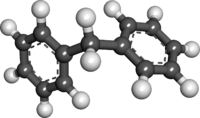Diphenylmethane
 | |
 | |
| Names | |
|---|---|
| Preferred IUPAC name
1,1'-Methylenedibenzene | |
| Other names
Diphenylmethane Benzylbenzene | |
| Identifiers | |
| 101-81-5 | |
| 3D model (Jmol) | Interactive image |
| Abbreviations | BnPh, Ph2CH2 |
| ChEBI | CHEBI:38884 |
| ChEMBL | ChEMBL1796022 |
| ChemSpider | 7299 |
| ECHA InfoCard | 100.002.708 |
| MeSH | Diphenylmethane |
| PubChem | 7580 |
| UNII | K3E387I0BC |
| |
| |
| Properties | |
| C13H12 | |
| Molar mass | 168.234 |
| Appearance | colourless oil |
| Density | 1.006 g/mL |
| Melting point | 22 to 24 °C (72 to 75 °F; 295 to 297 K) |
| Boiling point | 264 °C (507 °F; 537 K) |
| nonpolar organic solvents | |
| Hazards | |
| Main hazards | flammable |
| Flash point | > 110 °C; 230 °F; 383 K |
| Related compounds | |
| Related compounds |
Diphenylmethanol |
| Except where otherwise noted, data are given for materials in their standard state (at 25 °C [77 °F], 100 kPa). | |
| | |
| Infobox references | |
Diphenylmethane is an organic compound with the formula (C6H5)2CH2. The compound consists of methane wherein two hydrogen atoms are replaced by two phenyl groups. Diphenylmethane forms a common skeleton in organic chemistry; the diphenylmethyl group is also known as benzhydryl.
It is prepared by the Friedel-Crafts alkylation of benzyl chloride with benzene in the presence of a Lewis acid such as aluminium trichloride:[1]
- C6H5CH2Cl + C6H6 → (C6H5)2CH2 + HCl
See also
References
- ↑ W. W. Hartman and Ross Phillips (1943). "Diphenylmethane". Org. Synth.; Coll. Vol., 2, p. 232
This article is issued from Wikipedia - version of the 9/4/2016. The text is available under the Creative Commons Attribution/Share Alike but additional terms may apply for the media files.
